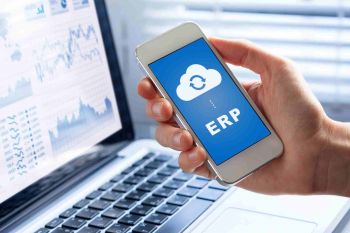Last Updated on juillet 4, 2023 by Tatyana Vandich
SaaS ERP: The Major Reasons to Deploy a Cloud-Based SaaS ERP
This post was updated to reflect current trends and information.
SaaS – Cloud computing involves housing a company’s data in a network of servers in a secure Data Centre (where all data is accessed over the Internet).
Software as a Service – is a popular distribution model where software applications are provided on a subscription basis.
ERP – Enterprise Resource Planning (ERP) is a fully integrated software management suite.

It is no wonder that Small and Medium Enterprises are choosing to go with cloud-based Software as a Service (SaaS) solutions. These companies can now implement a fully integrated ERP Management Suite without all of the traditional expenses required. No hardware installations, no in-house IT staff involved, no high software installation costs, and no initial software investments.
A SaaS ERP solution in the cloud only requires a low initial activation fee, a monthly per user subscription fee, a package of user training and support and a good Internet connection. There is now no excuse not to have an efficient Management System at your company.
Here are major reasons to deploy a cloud-based ERP Software Solution at your company:
SaaS ERP: Quick and Affordable Setup
The implementation* of an ERP Software System has always been associated with a lengthy (and costly) setup phase. Due to a high initial software license and hardware investment as well as the employment of a much-needed IT staff to help manage the system.
*There are many phases of an ERP implementation. Business Analysis, Project Planning, ERP selection, Hardware Installation, ERP Installation & Setup, Testing, Deployment, and User Training.
Typically, only large organizations considered implementing ERP solutions since they were the only ones able to afford the high investments required for this type of project. Even then, many executives were faced with unexpected costs that arose during ERP implementation. It’s no wonder that ERP implementations have gotten such a bad rap over the last decade or so. Time frames were never met, budgets were always surpassed and ERP Providers were not as supportive as they originally claimed.
SaaS and Cloud Computing
Fortunately, things have taken a turn (for the good) in the last couple of years. New technologies, new licensing types (SaaS), more deployment options (cloud) and more supportive and available smaller IT firms have emerged – leaving ERP implementations within budget, on time and accessible to the business of all sizes.
The emergence of SaaS and cloud computing has really allowed software setups and activations to be quick, simple and inexpensive. Fully integrated ERP suites can now be set up in a matter of days, requiring only a low activation fee. No hardware is required. Thus, companies can now rely on their IT Provider for all of their IT needs rather than hire an entire in-house team of IT professionals. Other expenses that surround this phase include user training, custom development (if requested), and any additional user support that is needed. No more hidden costs!
SaaS ERP: Subscription-Based Model
The other amazing aspect of implementing a cloud-based SaaS ERP solution is its licensing model, which is subscription-based. Companies are provided a license to use the software system (rather than have them buy these costly licenses.) This allows businesses to pay a monthly “per-user subscription” fee. Thus, you don’t have to worry about cloud hosting costs, bug fixes, and upgrades. The responsibility of the software system is on the shoulders of the ERP Provider and not on the company in question.
Your System Will Never Become Outdated
Quickly mentioned above, the monthly subscription fee includes all minor and major upgrades to the software system. Before there was SaaS, companies would need to pay additional costs to upgrade the system every few years (which adds up!)
In many cases, this upgrade required companies to go through an entirely new system implementation. This is due to the ERP provider making such dramatic changes to the system (where the old version was discontinued).
Therefore, setup fees and user training costs were once again required.
Thankfully, SaaS has made these upgrades very simple – these are continuous improvements made to the system that sometimes it is barely noticeable to the users. The ERP system can stay up-to-date no matter how many years have passed since initial implementation and at no extra cost.
Businesses will not need to go through multiple implementations for the same system!

SaaS ERP: Elimination of an In-House IT Department
Most small and mid-size business cannot afford to hire an entire in-house team of IT experts. Companies can collaborate with an IT Provider to handle all of their IT needs. As this point. It is critical that the chosen IT Partner is attentive, reliable and flexible.
There definitely needs to be a good fit between the customer and the IT Provider so that both can work together to achieve efficiency and process improvements.
Affordable Implementation ERP Solution for SMEs.
A SaaS ERP Management Suite, deployed in the cloud, has the potential to bring about many improvements to businesses of all sizes. With this solution, businesses can increase efficiency and streamline business processes without the hassles of long costly software implementations, large investments, and new IT staff recruitment.
Click here to learn about ErpWizard, our SaaS ERP Management Solution in the Cloud.



